Dual-Functional Tunable Metasurface for Meta-Axicon with a Variable Depth of Focus and Continuous-Zoom Metalens
Abstract
:1. Introduction
2. Materials and Methods
2.1. Phase Control Principle of DFTM
2.2. Design of Meta-Axicon with Variable DOF and NA
2.3. Design of Continuous-Zoom Metalens
2.4. Phase Profile Design of DFTM
3. Results
3.1. Characteristics of the Meta-Axicon Functionality
3.2. Characteristics of the Continuous-Zoom Metalens Functionality
4. Conclusions
Author Contributions
Funding
Data Availability Statement
Conflicts of Interest
References
- Yu, N.; Genevet, P.; Kats, M.A.; Aieta, F.; Tetienne, J.-P.; Capasso, F.; Gaburro, Z. Light Propagation with Phase Discontinuities: Generalized Laws of Reflection and Refraction. Science 2011, 334, 333–337. [Google Scholar] [CrossRef] [PubMed]
- Khorasaninejad, M.; Capasso, F. Broadband Multifunctional Efficient Meta-Gratings Based on Dielectric Waveguide Phase Shifters. Nano Lett. 2015, 15, 6709–6715. [Google Scholar] [CrossRef] [PubMed]
- Wang, C.; Liu, S.; Sun, Y.; Tao, X.; Sun, P.; Zhang, J.; Tao, C.; Wu, R.; Wu, F.; Zheng, Z. Tunable Beam Splitter Using Bilayer Geometric Metasurfaces in the Visible Spectrum. Opt. Express 2020, 28, 28672. [Google Scholar] [CrossRef]
- Khorasaninejad, M.; Chen, W.T.; Devlin, R.C.; Oh, J.; Zhu, A.Y.; Capasso, F. Metalenses at Visible Wavelengths: Diffraction-Limited Focusing and Subwavelength Resolution Imaging. Science 2016, 352, 1190–1194. [Google Scholar] [CrossRef]
- Chen, W.T.; Zhu, A.Y.; Sanjeev, V.; Khorasaninejad, M.; Shi, Z.; Lee, E.; Capasso, F. A Broadband Achromatic Metalens for Focusing and Imaging in the Visible. Nat. Nanotechnol. 2018, 13, 220–226. [Google Scholar] [CrossRef]
- Lin, R.J.; Su, V.-C.; Wang, S.; Chen, M.K.; Chung, T.L.; Chen, Y.H.; Kuo, H.Y.; Chen, J.-W.; Chen, J.; Huang, Y.-T. Achromatic Metalens Array for Full-Colour Light-Field Imaging. Nat. Nanotechnol. 2019, 14, 227–231. [Google Scholar] [CrossRef]
- Monakhova, K.; Yanny, K.; Yanny, K.; Aggarwal, N.; Waller, L.; Waller, L. Spectral DiffuserCam: Lensless Snapshot Hyperspectral Imaging with a Spectral Filter Array. Optica 2020, 7, 1298–1307. [Google Scholar] [CrossRef]
- Shalaginov, M.Y.; An, S.; Yang, F.; Su, P.; Lyzwa, D.; Agarwal, A.M.; Zhang, H.; Hu, J.; Gu, T. Single-Element Diffraction-Limited Fisheye Metalens. Nano Lett. 2020, 20, 7429–7437. [Google Scholar] [CrossRef] [PubMed]
- Wang, S.; Wu, P.C.; Su, V.-C.; Lai, Y.-C.; Chen, M.-K.; Kuo, H.Y.; Chen, B.H.; Chen, Y.H.; Huang, T.-T.; Wang, J.-H. A Broadband Achromatic Metalens in the Visible. Nat. Nanotechnol. 2018, 13, 227–232. [Google Scholar] [CrossRef]
- Wang, C.; Yu, Z.; Zhang, Q.; Sun, Y.; Tao, C.; Wu, F.; Zheng, Z. Metalens Eyepiece for 3D Holographic Near-Eye Display. Nanomaterials 2021, 11, 1920. [Google Scholar] [CrossRef]
- Aieta, F.; Genevet, P.; Kats, M.A.; Yu, N.; Blanchard, R.; Gaburro, Z.; Capasso, F. Aberration-Free Ultrathin Flat Lenses and Axicons at Telecom Wavelengths Based on Plasmonic Metasurfaces. Nano Lett. 2012, 12, 4932–4936. [Google Scholar] [CrossRef]
- Chen, W.T.; Khorasaninejad, M.; Zhu, A.Y.; Oh, J.; Devlin, R.C.; Zaidi, A.; Capasso, F. Generation of Wavelength-Independent Subwavelength Bessel Beams Using Metasurfaces. Light Sci. Appl. 2017, 6, e16259. [Google Scholar] [CrossRef] [PubMed]
- Lin, Z.; Li, X.; Zhao, R.; Song, X.; Wang, Y.; Huang, L. High-Efficiency Bessel Beam Array Generation by Huygens Metasurfaces. Nanophotonics 2019, 8, 1079–1085. [Google Scholar] [CrossRef]
- Zhou, Q.; Liu, M.; Zhu, W.; Chen, L.; Ren, Y.; Lezec, H.J.; Lu, Y.; Agrawal, A.; Xu, T. Generation of Perfect Vortex Beams by Dielectric Geometric Metasurface for Visible Light. Laser Photonics Rev. 2021, 15, 2100390. [Google Scholar] [CrossRef]
- Fan, Y.; Cluzel, B.; Petit, M.; Le Roux, X.; Lupu, A.; De Lustrac, A. 2D Waveguided Bessel Beam Generated Using Integrated Metasurface-Based Plasmonic Axicon. ACS Appl. Mater. Interfaces 2020, 12, 21114–21119. [Google Scholar] [CrossRef]
- Lee, G.-Y.; Yoon, G.; Lee, S.-Y.; Yun, H.; Cho, J.; Lee, K.; Kim, H.; Rho, J.; Lee, B. Complete Amplitude and Phase Control of Light Using Broadband Holographic Metasurfaces. Nanoscale 2018, 10, 4237–4245. [Google Scholar] [CrossRef]
- Jin, L.; Dong, Z.; Mei, S.; Yu, Y.F.; Wei, Z.; Pan, Z.; Rezaei, S.D.; Li, X.; Kuznetsov, A.I.; Kivshar, Y.S.; et al. Noninterleaved Metasurface for (26-1) Spin- and Wavelength-Encoded Holograms. Nano Lett. 2018, 18, 8016–8024. [Google Scholar] [CrossRef]
- Sung, J.; Lee, G.-Y.; Lee, B. Progresses in the Practical Metasurface for Holography and Lens. Nanophotonics 2019, 8, 1701–1718. [Google Scholar] [CrossRef]
- Zhao, Y.; Alù, A. Tailoring the Dispersion of Plasmonic Nanorods To Realize Broadband Optical Meta-Waveplates. Nano Lett. 2013, 13, 1086–1091. [Google Scholar] [CrossRef]
- Kim, J.; Choudhury, S.; DeVault, C.; Zhao, Y.; Kildishev, A.V.; Shalaev, V.M.; Alù, A.; Boltasseva, A. Controlling the Polarization State of Light with Plasmonic Metal Oxide Metasurface. ACS Nano 2016, 10, 9326–9333. [Google Scholar] [CrossRef]
- Xu, Y.; Li, Q.; Zhang, X.; Wei, M.; Xu, Q.; Wang, Q.; Zhang, H.; Zhang, W.; Hu, C.; Zhang, Z.; et al. Spin-Decoupled Multifunctional Metasurface for Asymmetric Polarization Generation. ACS Photonics 2019, 6, 2933–2941. [Google Scholar] [CrossRef]
- Xu, H.-X.; Wang, C.; Hu, G.; Wang, Y.; Tang, S.; Huang, Y.; Ling, X.; Huang, W.; Qiu, C.-W. Spin-Encoded Wavelength-Direction Multitasking Janus Metasurfaces. Adv. Opt. Mater. 2021, 9, 2100190. [Google Scholar] [CrossRef]
- Wang, S.; Deng, Z.-L.; Wang, Y.; Zhou, Q.; Wang, X.; Cao, Y.; Guan, B.-O.; Xiao, S.; Li, X. Arbitrary Polarization Conversion Dichroism Metasurfaces for All-in-One Full Poincaré Sphere Polarizers. Light Sci. Appl. 2021, 10, 24. [Google Scholar] [CrossRef] [PubMed]
- Lin, D.; Holsteen, A.L.; Maguid, E.; Wetzstein, G.; Kik, P.G.; Hasman, E.; Brongersma, M.L. Photonic Multitasking Interleaved Si Nanoantenna Phased Array. Nano Lett. 2016, 16, 7671–7676. [Google Scholar] [CrossRef]
- Hu, Y.; Li, L.; Wang, Y.; Meng, M.; Jin, L.; Luo, X.; Chen, Y.; Li, X.; Xiao, S.; Wang, H.; et al. Trichromatic and Tripolarization-Channel Holography with Noninterleaved Dielectric Metasurface. Nano Lett. 2020, 20, 994–1002. [Google Scholar] [CrossRef]
- Kamali, S.M.; Arbabi, E.; Arbabi, A.; Horie, Y.; Faraji-Dana, M.; Faraon, A. Angle-Multiplexed Metasurfaces: Encoding Independent Wavefronts in a Single Metasurface under Different Illumination Angles. Phys. Rev. X 2017, 7, 041056. [Google Scholar] [CrossRef]
- Deng, Z.-L.; Deng, J.; Zhuang, X.; Wang, S.; Li, K.; Wang, Y.; Chi, Y.; Ye, X.; Xu, J.; Wang, G.P.; et al. Diatomic Metasurface for Vectorial Holography. Nano Lett. 2018, 18, 2885–2892. [Google Scholar] [CrossRef] [PubMed]
- Maguid, E.; Yulevich, I.; Veksler, D.; Kleiner, V.; Brongersma, M.L.; Hasman, E. Photonic Spin-Controlled Multifunctional Shared-Aperture Antenna Array. Science 2016, 352, 1202–1206. [Google Scholar] [CrossRef]
- Wang, B.; Dong, F.; Yang, D.; Song, Z.; Xu, L.; Chu, W.; Gong, Q.; Li, Y. Polarization-Controlled Color-Tunable Holograms with Dielectric Metasurfaces. Optica 2017, 4, 1368–1371. [Google Scholar] [CrossRef]
- Khorasaninejad, M.; Chen, W.T.; Zhu, A.Y.; Oh, J.; Devlin, R.C.; Rousso, D.; Capasso, F. Multispectral Chiral Imaging with a Metalens. Nano Lett. 2016, 16, 4595–4600. [Google Scholar] [CrossRef]
- Malek, S.C.; Overvig, A.C.; Shrestha, S.; Yu, N. Active Nonlocal Metasurfaces. Nanophotonics 2021, 10, 655–665. [Google Scholar] [CrossRef]
- Overvig, A.C.; Malek, S.C.; Yu, N. Multifunctional Nonlocal Metasurfaces. Phys. Rev. Lett. 2020, 125, 017402. [Google Scholar] [CrossRef]
- Ding, F.; Wang, Z.; He, S.; Shalaev, V.M.; Kildishev, A.V. Broadband High-Efficiency Half-Wave Plate: A Supercell-Based Plasmonic Metasurface Approach. ACS Nano 2015, 9, 4111–4119. [Google Scholar] [CrossRef] [PubMed]
- Moccia, M.; Liu, S.; Wu, R.Y.; Castaldi, G.; Andreone, A.; Cui, T.J.; Galdi, V. Coding Metasurfaces for Diffuse Scattering: Scaling Laws, Bounds, and Suboptimal Design. Adv. Opt. Mater. 2017, 5, 1700455. [Google Scholar] [CrossRef]
- Neder, V.; Ra’di, Y.; Alù, A.; Polman, A. Combined Metagratings for Efficient Broad-Angle Scattering Metasurface. ACS Photonics 2019, 6, 1010–1017. [Google Scholar] [CrossRef]
- Yeung, C.; Tsai, J.-M.; King, B.; Pham, B.; Ho, D.; Liang, J.; Knight, M.W.; Raman, A.P. Multiplexed Supercell Metasurface Design and Optimization with Tandem Residual Networks. Nanophotonics 2021, 10, 1133–1143. [Google Scholar] [CrossRef]
- Cui, Y.; Zheng, G.; Zheng, G.; Chen, M.; Zhang, Y.; Yang, Y.; Tao, J.; He, T.; Li, Z.; Li, Z. Reconfigurable Continuous-Zoom Metalens in Visible Band. Chin. Opt. Lett. COL 2019, 17, 111603. [Google Scholar] [CrossRef]
- Du, Z.; Hu, B.; Liu, W.; Liu, J.; Wang, Y. Tunable Beam Deflector by Mutual Motion of Cascaded Bilayer Metasurfaces. J. Opt. 2019, 21, 115101. [Google Scholar] [CrossRef]
- Sun, Y.; Wang, C.; Zheng, S.; Tao, X.; Liu, X.; Li, Y.; Wu, F.; Zheng, Z. Double-Layer Polarization-Independent Achromatic Metasurface Array for Optical Fiber Bundle Coupling in Microendoscope. Sci. Rep. 2022, 12, 20476. [Google Scholar] [CrossRef] [PubMed]
- Wang, C.; Sun, Y.; Zhang, Q.; Yu, Z.; Tao, C.; Zhang, J.; Wu, F.; Wu, R.; Zheng, Z. Continuous-Zoom Bifocal Metalens by Mutual Motion of Cascaded Bilayer Metasurfaces in the Visible. Opt. Express 2021, 29, 26569. [Google Scholar] [CrossRef]
- Colburn, S.; Zhan, A.; Majumdar, A. Varifocal Zoom Imaging with Large Area Focal Length Adjustable Metalenses. Optica 2018, 5, 825–831. [Google Scholar] [CrossRef]
- Wei, Y.; Wang, Y.; Feng, X.; Xiao, S.; Wang, Z.; Hu, T.; Hu, M.; Song, J.; Wegener, M.; Zhao, M.; et al. Compact Optical Polarization-Insensitive Zoom Metalens Doublet. Adv. Opt. Mater. 2020, 8, 2000142. [Google Scholar] [CrossRef]
- Yang, F.; Lin, H.-I.; Shalaginov, M.Y.; Stoll, K.; An, S.; Rivero-Baleine, C.; Kang, M.; Agarwal, A.; Richardson, K.; Zhang, H.; et al. Reconfigurable Parfocal Zoom Metalens. Adv. Opt. Mater. 2022, 10, 2200721. [Google Scholar] [CrossRef]
- Hail, C.U.; Michel, A.-K.U.; Poulikakos, D.; Eghlidi, H. Optical Metasurfaces: Evolving from Passive to Adaptive. Adv. Opt. Mater. 2019, 7, 1801786. [Google Scholar] [CrossRef]
- Kang, L.; Jenkins, R.P.; Werner, D.H. Recent Progress in Active Optical Metasurfaces. Adv. Opt. Mater. 2019, 7, 1801813. [Google Scholar] [CrossRef]
- Chen, Y.; Duan, X.; Matuschek, M.; Zhou, Y.; Neubrech, F.; Duan, H.; Liu, N. Dynamic Color Displays Using Stepwise Cavity Resonators. Nano Lett. 2017, 17, 5555–5560. [Google Scholar] [CrossRef]
- Wu, Y.; Chen, Y.; Song, Q.; Xiao, S. Dynamic Structural Colors Based on All-Dielectric Mie Resonators. Adv. Opt. Mater. 2021, 9, 2002126. [Google Scholar] [CrossRef]
- Duan, X.; Liu, N. Magnesium for Dynamic Nanoplasmonics. Acc. Chem. Res. 2019, 52, 1979–1989. [Google Scholar] [CrossRef] [PubMed]
- Lininger, A.; Zhu, A.Y.; Park, J.-S.; Palermo, G.; Chatterjee, S.; Boyd, J.; Capasso, F.; Strangi, G. Optical Properties of Metasurfaces Infiltrated with Liquid Crystals. Proc. Natl. Acad. Sci. USA 2020, 117, 20390–20396. [Google Scholar] [CrossRef] [PubMed]
- Palermo, G.; Lininger, A.; Guglielmelli, A.; Ricciardi, L.; Nicoletta, G.; De Luca, A.; Park, J.-S.; Lim, S.W.D.; Meretska, M.L.; Capasso, F.; et al. All-Optical Tunability of Metalenses Permeated with Liquid Crystals. ACS Nano 2022, 16, 16539–16548. [Google Scholar] [CrossRef] [PubMed]
- Lio, G.E.; Ferraro, A.; Ritacco, T.; Aceti, D.M.; De Luca, A.; Giocondo, M.; Caputo, R. Leveraging on ENZ Metamaterials to Achieve 2D and 3D Hyper-Resolution in Two-Photon Direct Laser Writing. Adv. Mater. 2021, 33, 2008644. [Google Scholar] [CrossRef]
- Li, J.; Kamin, S.; Zheng, G.; Neubrech, F.; Zhang, S.; Liu, N. Addressable Metasurfaces for Dynamic Holography and Optical Information Encryption. Sci. Adv. 2018, 4, eaar6768. [Google Scholar] [CrossRef]
- Zhang, C.; Xiao, S.; Wang, Y.; Gao, Y.; Fan, Y.; Huang, C.; Zhang, N.; Yang, W.; Song, Q. Lead Halide Perovskite-Based Dynamic Metasurfaces. Laser Photonics Rev. 2019, 13, 1900079. [Google Scholar] [CrossRef]
- Wu, Y.; Yang, W.; Fan, Y.; Song, Q.; Xiao, S. TiO2 Metasurfaces: From Visible Planar Photonics to Photochemistry. Sci. Adv. 2019, 5, eaax0939. [Google Scholar] [CrossRef] [PubMed]
- Arbabi, E.; Arbabi, A.; Kamali, S.M.; Horie, Y.; Faraji-Dana, M.; Faraon, A. MEMS-Tunable Dielectric Metasurface Lens. Nat. Commun. 2018, 9, 812. [Google Scholar] [CrossRef]
- Kamali, S.M.; Arbabi, A.; Arbabi, E.; Horie, Y.; Faraon, A. Decoupling Optical Function and Geometrical Form Using Conformal Flexible Dielectric Metasurfaces. Nat. Commun. 2016, 7, 11618. [Google Scholar] [CrossRef] [PubMed]
- Tseng, M.L.; Yang, J.; Semmlinger, M.; Zhang, C.; Nordlander, P.; Halas, N.J. Two-Dimensional Active Tuning of an Aluminum Plasmonic Array for Full-Spectrum Response. Nano Lett. 2017, 17, 6034–6039. [Google Scholar] [CrossRef]
- Cerjan, B.; Gerislioglu, B.; Link, S.; Nordlander, P.; Halas, N.J.; Griep, M.H. Towards Scalable Plasmonic Fano-Resonant Metasurfaces for Colorimetric Sensing. Nanotechnology 2022, 33, 405201. [Google Scholar] [CrossRef]
- Sun, W.-Q.; Wang, Y.-H.; Xu, Z.-L.; Fang, X.; Chuang, K.-C. A Locally Disordered Metamaterial for Directing and Trapping Water Waves. Crystals 2023, 13, 826. [Google Scholar] [CrossRef]
- Hu, Y.; Ou, X.; Zeng, T.; Lai, J.; Zhang, J.; Li, X.; Luo, X.; Li, L.; Fan, F.; Duan, H. Electrically Tunable Multifunctional Polarization-Dependent Metasurfaces Integrated with Liquid Crystals in the Visible Region. Nano Lett. 2021, 21, 4554–4562. [Google Scholar] [CrossRef]
- Shirmanesh, G.K.; Sokhoyan, R.; Wu, P.C.; Atwater, H.A. Electro-Optically Tunable Multifunctional Metasurfaces. ACS Nano 2020, 14, 6912–6920. [Google Scholar] [CrossRef]
- Deng, L.; Deng, J.; Guan, Z.; Tao, J.; Chen, Y.; Yang, Y.; Zhang, D.; Tang, J.; Li, Z.; Li, Z.; et al. Malus-Metasurface-Assisted Polarization Multiplexing. Light Sci. Appl. 2020, 9, 101. [Google Scholar] [CrossRef] [PubMed]
- Balthasar Mueller, J.P.; Rubin, N.A.; Devlin, R.C.; Groever, B.; Capasso, F. Metasurface Polarization Optics: Independent Phase Control of Arbitrary Orthogonal States of Polarization. Phys. Rev. Lett. 2017, 118, 113901. [Google Scholar] [CrossRef] [PubMed]
- Du, K.; Barkaoui, H.; Zhang, X.; Jin, L.; Song, Q.; Xiao, S. Optical Metasurfaces towards Multifunctionality and Tunability. Nanophotonics 2022, 11, 1761–1781. [Google Scholar] [CrossRef]
- Tian, S.; Guo, H.; Hu, J.; Zhuang, S. Dielectric Longitudinal Bifocal Metalens with Adjustable Intensity and High Focusing Efficiency. Opt. Express 2019, 27, 680–688. [Google Scholar] [CrossRef]
- Siefke, T.; Kroker, S.; Pfeiffer, K.; Puffky, O.; Dietrich, K.; Franta, D.; Ohlídal, I.; Szeghalmi, A.; Kley, E.-B.; Tünnermann, A. Materials Pushing the Application Limits of Wire Grid Polarizers Further into the Deep Ultraviolet Spectral Range. Adv. Opt. Mater. 2016, 4, 1780–1786. [Google Scholar] [CrossRef]
- Bernet, S.; Ritsch-Marte, M. Adjustable Refractive Power from Diffractive Moiré Elements. Appl. Opt. 2008, 47, 3722–3730. [Google Scholar] [CrossRef]
- Hu, G.; Wang, M.; Mazor, Y.; Qiu, C.-W.; Alù, A. Tailoring Light with Layered and Moiré Metasurfaces. Trends Chem. 2021, 3, 342–358. [Google Scholar] [CrossRef]
- Kamali, S.M.; Arbabi, E.; Arbabi, A.; Horie, Y.; Faraon, A. Highly Tunable Elastic Dielectric Metasurface Lenses. Laser Photonics Rev. 2016, 10, 1002–1008. [Google Scholar] [CrossRef]
- Yilmaz, N.; Ozdemir, A.; Ozer, A.; Kurt, H. Rotationally Tunable Polarization-Insensitive Single and Multifocal Metasurface. J. Opt. 2019, 21, 045105. [Google Scholar] [CrossRef]

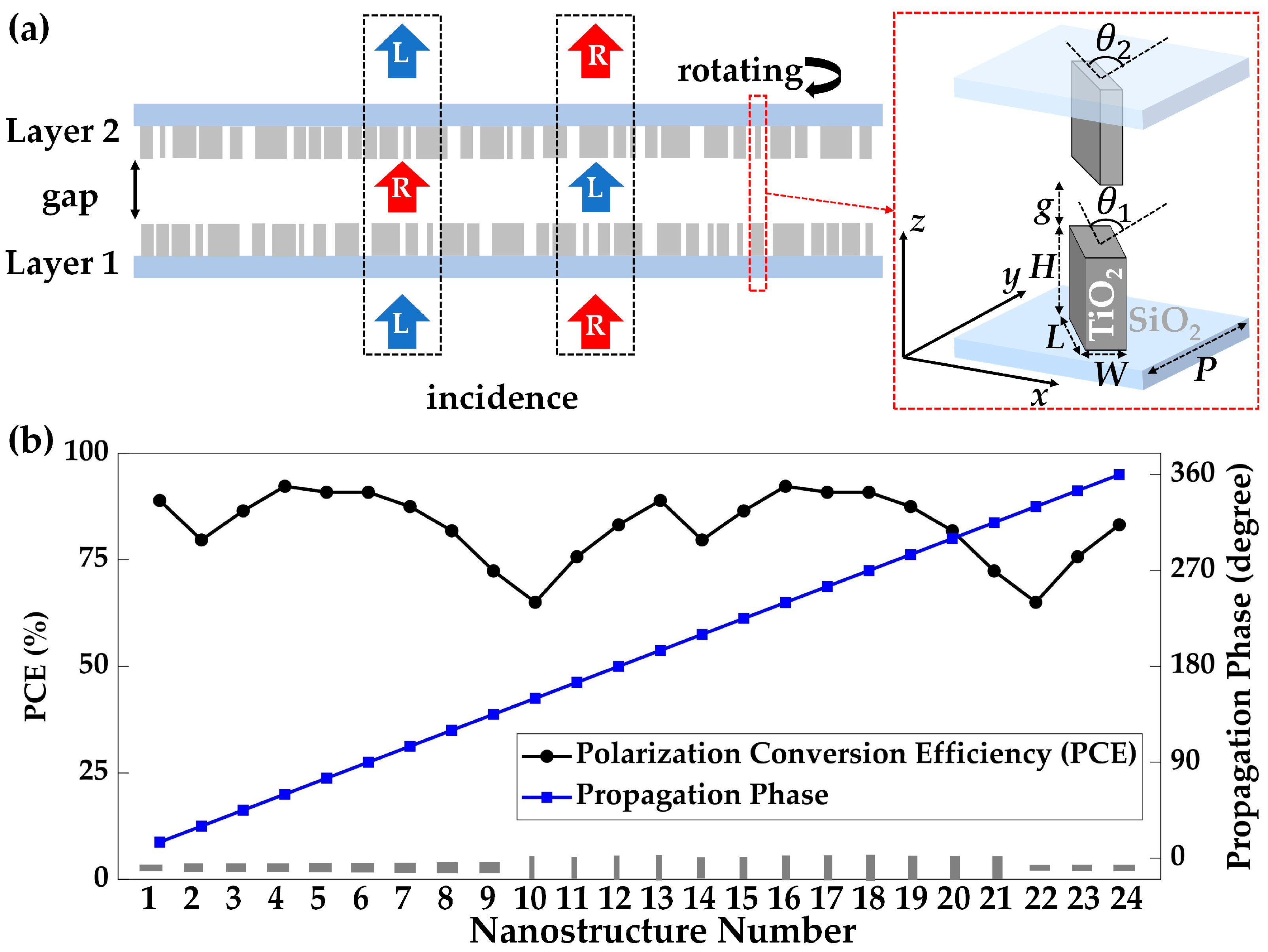
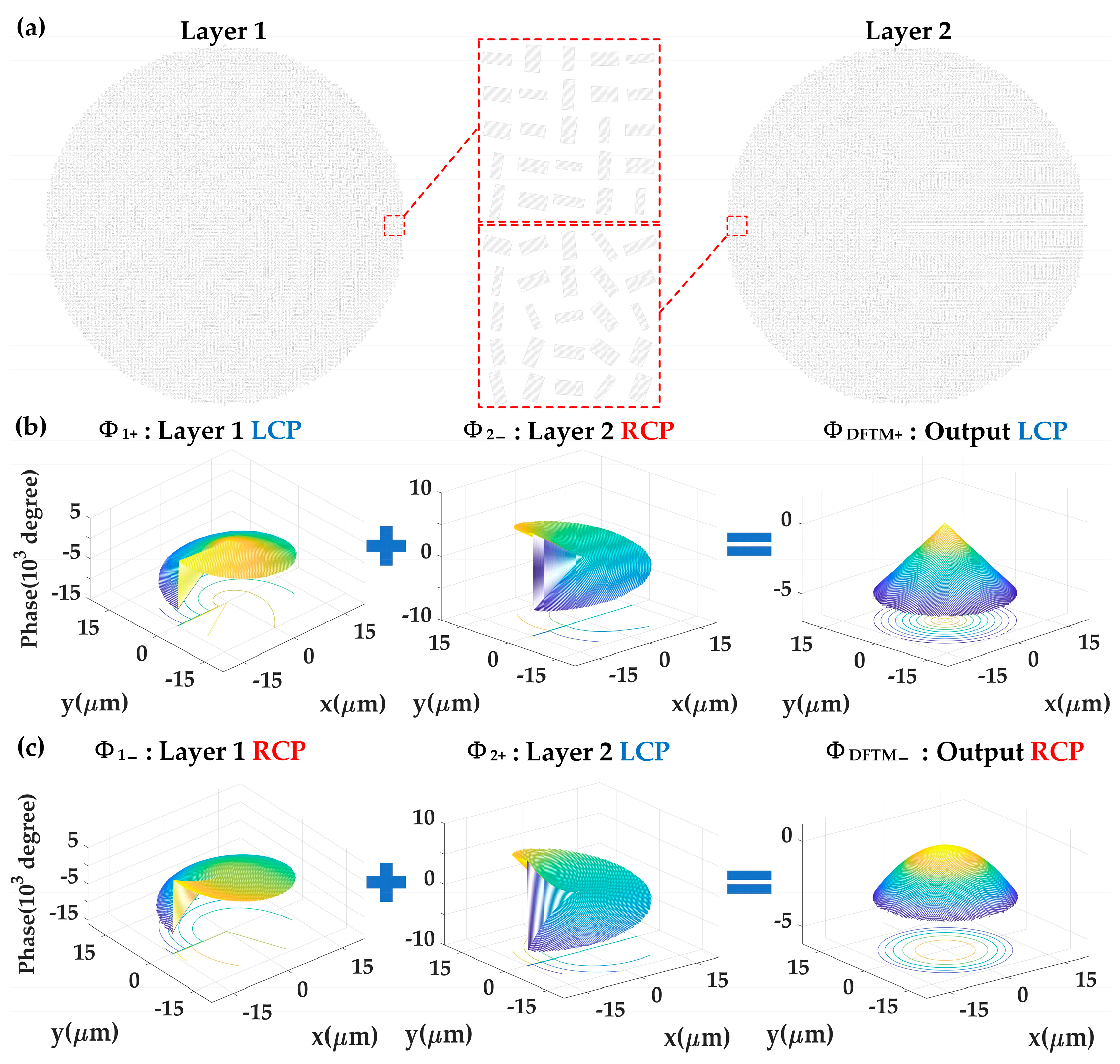
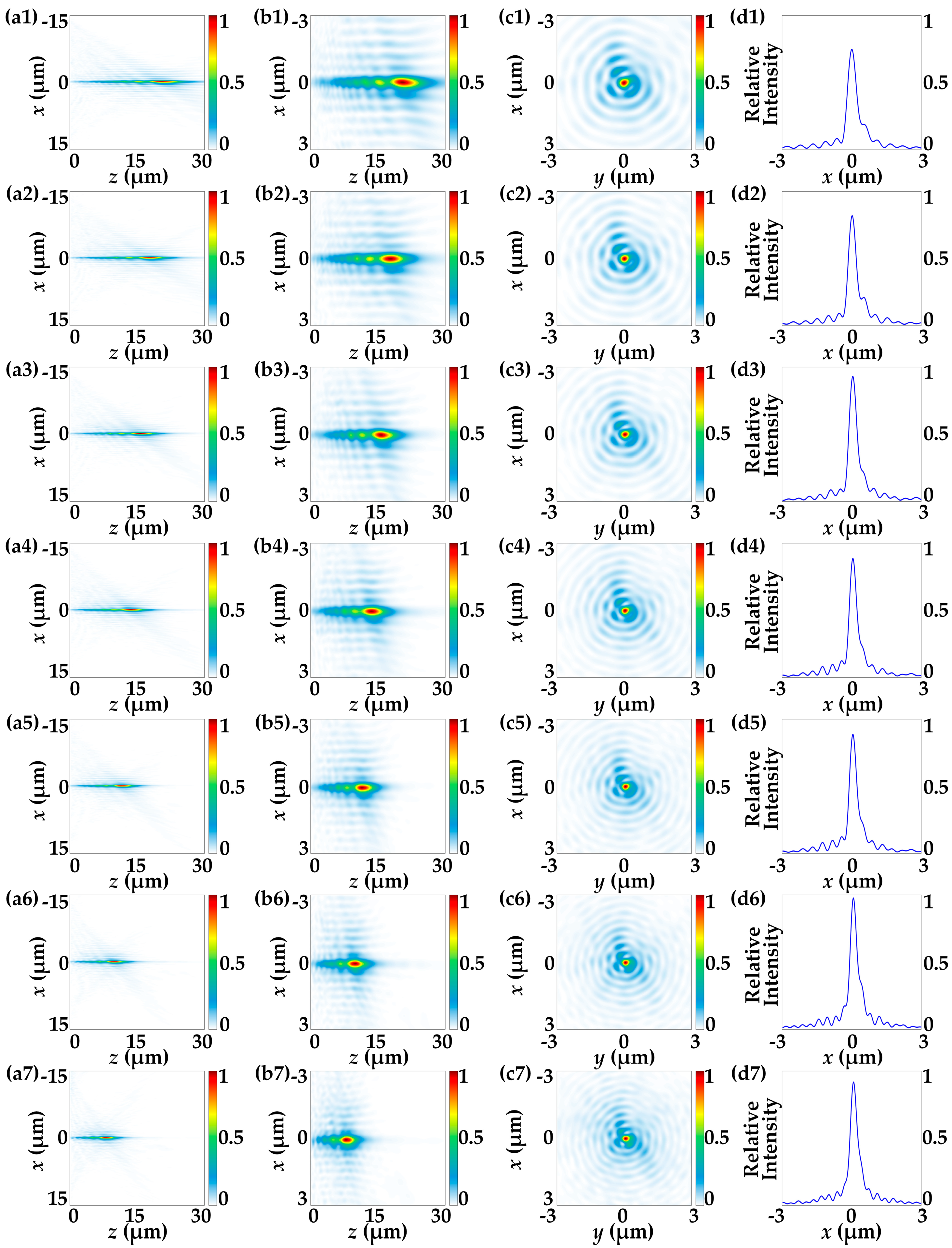
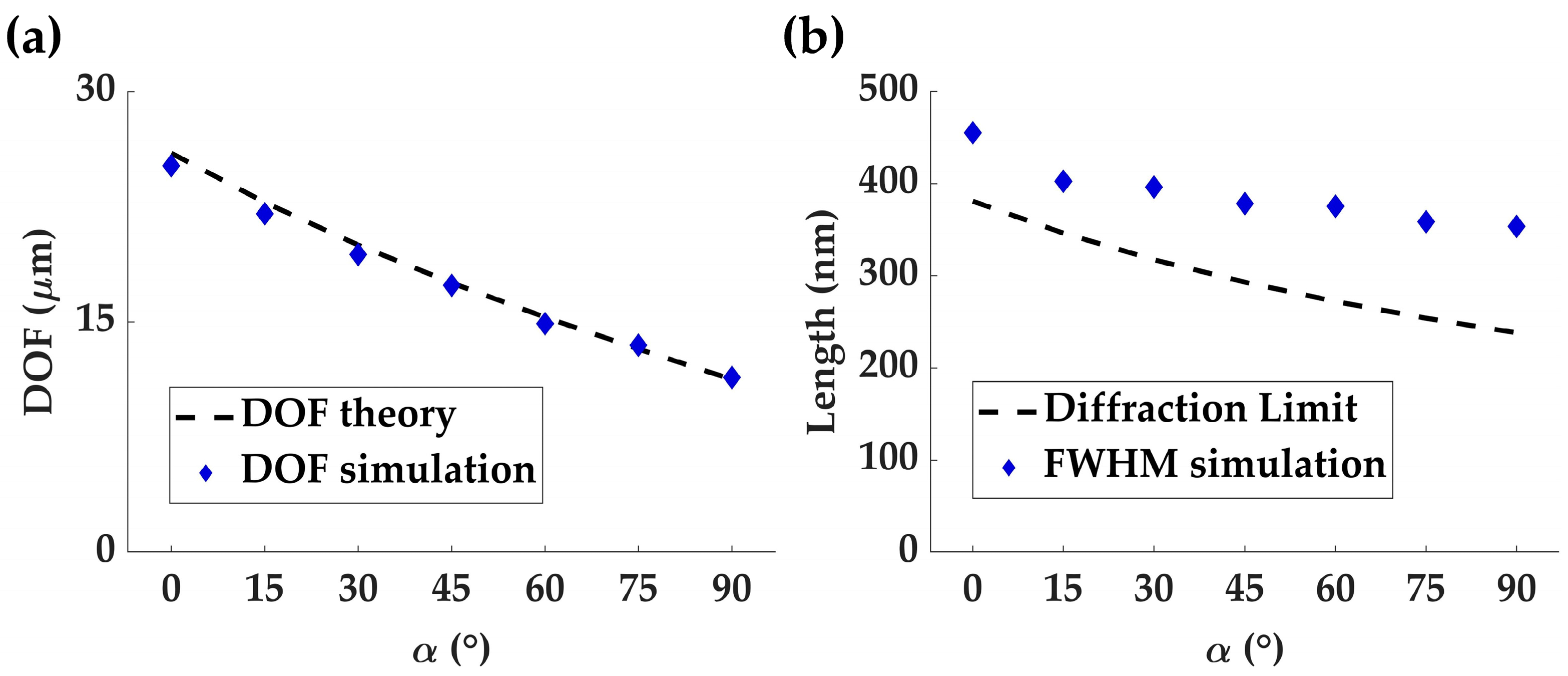
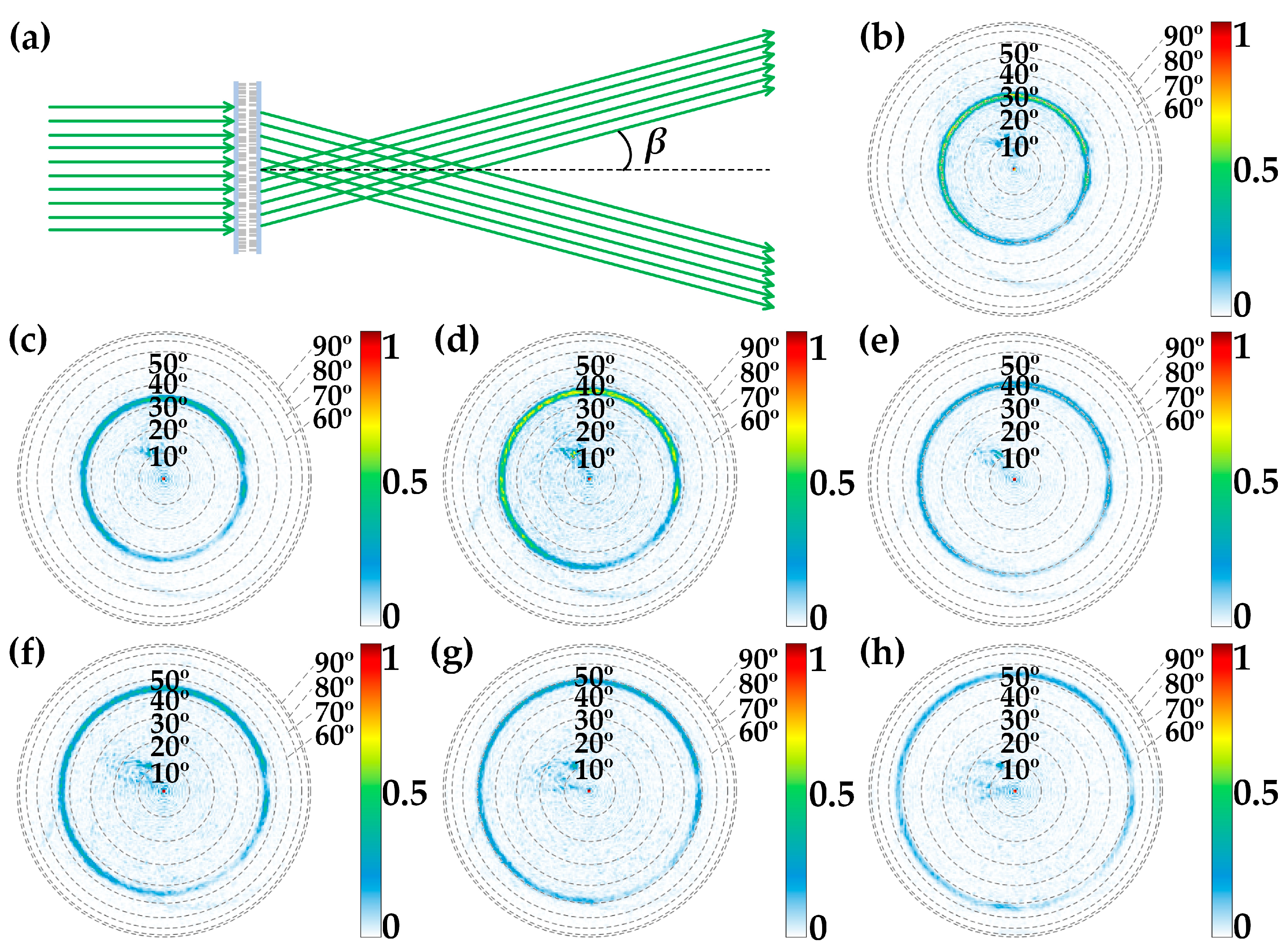
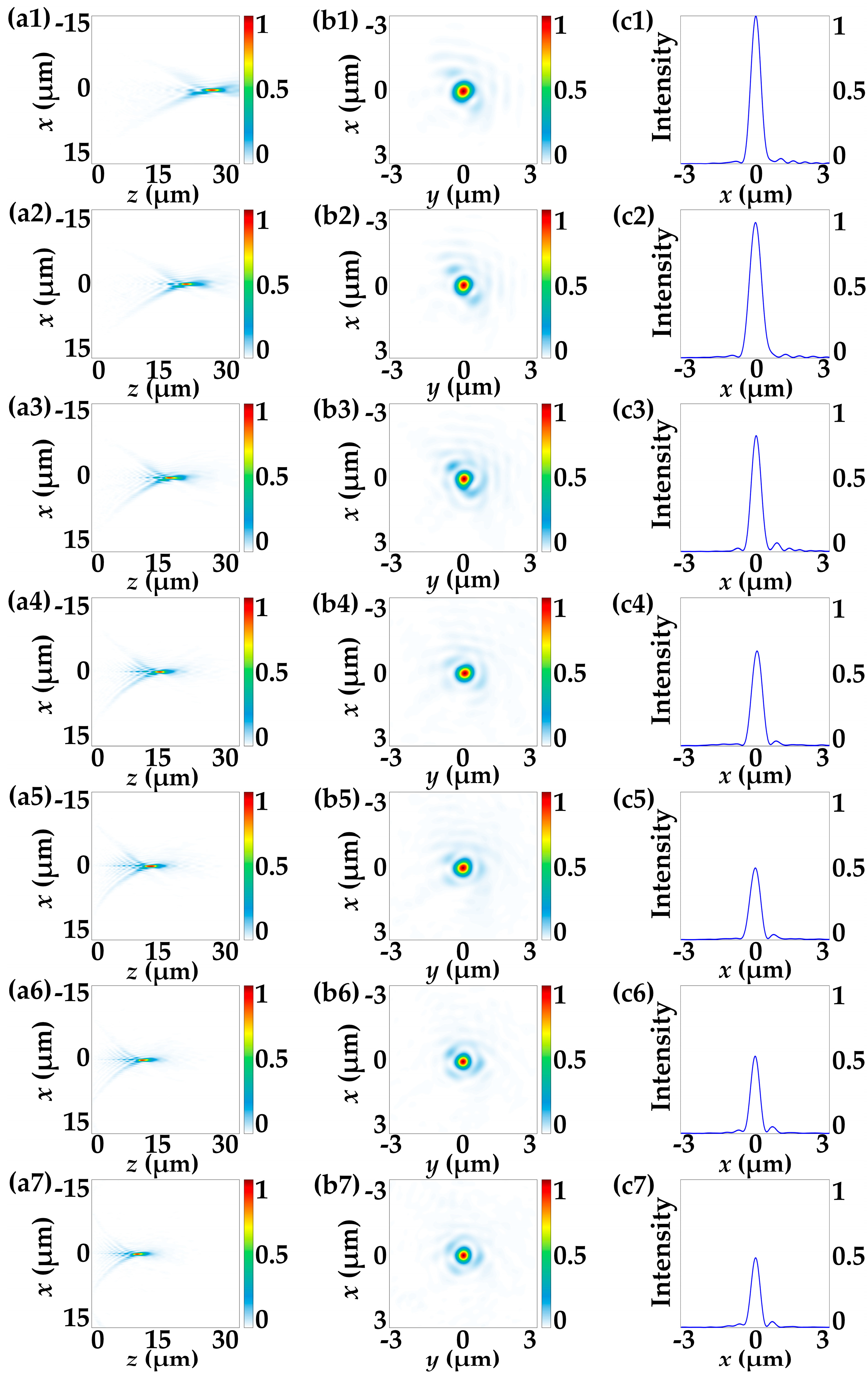

Disclaimer/Publisher’s Note: The statements, opinions and data contained in all publications are solely those of the individual author(s) and contributor(s) and not of MDPI and/or the editor(s). MDPI and/or the editor(s) disclaim responsibility for any injury to people or property resulting from any ideas, methods, instructions or products referred to in the content. |
© 2023 by the authors. Licensee MDPI, Basel, Switzerland. This article is an open access article distributed under the terms and conditions of the Creative Commons Attribution (CC BY) license (https://creativecommons.org/licenses/by/4.0/).
Share and Cite
Wang, C.; Sun, Y.; Yu, Z.; Liu, X.; Chen, B.; Zhang, Y.; Zheng, Z. Dual-Functional Tunable Metasurface for Meta-Axicon with a Variable Depth of Focus and Continuous-Zoom Metalens. Nanomaterials 2023, 13, 2530. https://doi.org/10.3390/nano13182530
Wang C, Sun Y, Yu Z, Liu X, Chen B, Zhang Y, Zheng Z. Dual-Functional Tunable Metasurface for Meta-Axicon with a Variable Depth of Focus and Continuous-Zoom Metalens. Nanomaterials. 2023; 13(18):2530. https://doi.org/10.3390/nano13182530
Chicago/Turabian StyleWang, Chang, Yan Sun, Zeqing Yu, Xinyu Liu, Bingliang Chen, Yang Zhang, and Zhenrong Zheng. 2023. "Dual-Functional Tunable Metasurface for Meta-Axicon with a Variable Depth of Focus and Continuous-Zoom Metalens" Nanomaterials 13, no. 18: 2530. https://doi.org/10.3390/nano13182530




